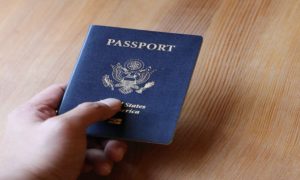Sitting on train tracks a few hundred feet south of the U.S. border, Nathalie Gonzalez, 23, pulled her 4-year-old daughter a little closer. Night was coming. She had no idea where they would sleep.
They had journeyed 3,000 miles from Venezuela to seek asylum, slogging through jungles, hiding in cargo trains and begging on streets for food. At last they had arrived in this chilly industrial city in northern Mexico, where the only thing that now separated them from the United States was a trickle of river, a line of National Guard troops and the new patchwork of U.S. immigration policies that had stranded them here.
Read More:-3 Energy Stocks to Buy No Matter What Happens to Oil Prices in 2023
“It’s so close,” Gonzalez said, staring at the El Paso skyline. “But so far.”

As President Biden prepares to visit El Paso on Sunday, his first trip to the border since taking office two years ago, this is his legacy: Thousands of people from some of the world’s most oppressive countries marooned in Mexico because of his expansion of a Trump administration policy that allows border agents to immediately expel migrants without considering their asylum claims.
Read More:-What is gaslighting? Here’s what it is and how to respond to the behavior.
In recent years, even as hundreds of thousands of migrants from Mexico, Central America and elsewhere were swiftly deported under Title 42, a rule invoked by ex-President Trump that allows the government to impede the entry of foreigners during a public health emergency, people from Cuba, Nicaragua, Venezuela and a handful of other countries were generally allowed to enter the U.S., given temporary work permits and granted asylum hearings.
Read More:-15 Benefits of Facebook Marketplace for Business
Their home countries were simply too unstable or too politically at odds with the United States for agents to coordinate mass deportations.
But as a surge of migrants from those countries overwhelmed U.S. border towns in recent months, leading local officials to plead for federal help, the Biden administration began sending Venezuelans arriving at the border back to Mexico without giving them asylum hearings.
Read More:-Tesla Now Over 40% Cheaper in China Than US as Prices Cut Again
On Thursday, Biden expanded that policy, saying people from Cuba, Nicaragua and Haiti would also be immediately sent back to Mexico.

Do not just show up at the border,” Biden said in a speech announcing the new approach. “Stay where you are and apply legally from there.”
Biden also announced a new pathway to legal entry for people from the four countries, saying that as many as 30,000 of them per month would be allowed into the U.S. if they applied via an online application from their home country, found a U.S.-based sponsor, passed a rigorous background check and purchased a plane ticket.
But many criticize the plan as unrealistic, with Sen. Robert Menendez (D-N.J.) saying it “will exclude migrants fleeing violence and persecution who do not have the ability or economic means to qualify.”
The flurry of changes leaves people like Gonzalez, her daughter and others who had already begun the journey to the U.S. with few options. Gonzalez said she sees no choice now but to try to sneak into Texas illegally.
“We’re afraid. We don’t want to do it this way,” Gonzalez said. But the thought of staying in Mexico — with its drug gangs and extortion — terrifies her. And back home in Venezuela, she said, “the minimum wage is $30 a month and my daughter has nothing to eat.”
Biden said this week that he hopes his administration’s new plan will “substantially reduce” the number of people attempting to cross the border.

He announced the plan amid mounting pressure from officials in cities including El Paso, where in recent weeks, thousands of migrants have been camped on sidewalks in near-freezing temperatures. El Paso Mayor Oscar Leeser, a Democrat, declared a state of emergency. With local shelters overrun, the city has been offering migrants places to sleep on city buses.
The city had been bracing for even more migrants last month, when Title 42 was supposed to be lifted, per order of a federal judge who ruled that it was being used arbitrarily and was no longer justified as a pandemic health measure.
Some 19 Republican-led states appealed to the Supreme Court, and the court ruled that Title 42 would remain in place until the high court decided a case. Even if it is eventually lifted, the new Biden policies applying to Venezuelans, Cubans, Nicaraguans and Haitians would remain.
While the new guidelines may relieve stress on American communities, they are already putting pressure on Mexican cities.
Inside a Mexican government office underneath a bridge that connects El Paso to Juarez, Enrique Valenzuela stood before a crowd of bedraggled migrants who had recently been deported from the U.S. and told them a difficult truth.
“They don’t want you there,” Valenzuela said of American officials. “They want you here.

A burly man dressed in a flannel coat, Valenzuela has helped coordinate migrant assistance for the Mexican state of Chihuahua for five years. In that time he has seen multiple iterations of U.S. immigration policy that have been aimed at keeping as many migrants as possible in Mexico, and he believes that part of his job is to help migrants come to terms with reality.
Juarez, he told them, was a city packed with people from other parts of Mexico who had come to work factory jobs. “We’re all the grandchildren of immigrants,” he said.
“You’re here now,” he said. “You need to try to find work. You need to integrate yourself into society.”
The migrants looked at him warily. One young man wore a sign around his neck that he had used to raise donations for his journey to the U.S. It said: “Help us realize our dream.”
When one of the recent returnees asked about how to find a place to stay, Valenzuela said there were shelters.
“We have spaces today, right?” he asked a young assistant.
She shook her head no.
“We already filled up?” he said, with a look of incredulity.
She nodded. Valenzuela sighed and vowed to call around to local pastors to see if any churches had space.
“We’re on the cusp of another emergency,” he said in an interview later. Once again, he said, Mexico would be left to grapple “with decisions made in the United States.”
Unlike some past changes, the new enforcement rules appear to have Mexico’s blessing.
Under the new plan, Mexico agreed to accept deportees from Cuba, Nicaragua, Venezuela and Haiti, which it hadn’t done in the past.
Biden’s announcement came just days prior to his first official visit to Mexico, where he will fly after his event in El Paso for a two-day summit with Mexican President Andrés Manuel López Obrador and Canadian Prime Minister Justin Trudeau.
Immigration is one of a number of issues including climate change, manufacturing, security and trade that the leaders are expected to discuss.
The discussions will occur in Mexico City, far from many of those whose lives they have the potential to affect. Like Leonela Murillo Leal, 20, who on a recent afternoon was asking for handouts in downtown Juarez with an infant on her hip while she tried to keep her two older children from running into the road.
To occupy them for a few minutes, she used the few pesos someone had just handed her to buy popsicles.
She and her husband, José Arteaga Farrilla, 31, left Venezuela five years ago, at a time when the country was roiled by food scarcities, soaring inflation and bloody street protests calling for the removal of leftist dictator Nicolas Maduro. They joined hundreds of thousands of Venezuelans who fled to Ecuador, and later went to live in Chile, but said they couldn’t find enough work and faced xenophobia.
When they heard Venezuelans were being allowed into the U.S., they headed north, at one point trekking on foot for 70 miles through the Darien Gap, the thick jungle that connects South and Central America.
“The kids had fevers and diarrhea,” Murillo said. “We saw dead people. It was ugly.”
“A lot of people told us we wouldn’t make it,” Arteaga said.
But they had. The family crossed into the U.S. from the town of Piedras Negras on Dec. 21 and were promptly returned across the border. For nine days, they were held there in a Mexican immigration facility, passing Christmas and New Year’s Eve. When they got out, they hopped a cargo train to Juarez.
They had heard that Biden was coming to the border there for a visit. There were rumors circulating that he might make a benevolent announcement. “We’re going to wait to see what the president says,” said Arteaga. “Some say he’s going to let people in.”



































